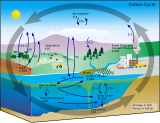This article includes a list of general references, but it lacks sufficient corresponding inline citations. (November 2020) |

| Part of a series on the |
| Carbon cycle |
|---|
 |
Kerogen is solid, insoluble organic matter in sedimentary rocks. It consists of a variety of organic materials, including dead plants, algae, and other microorganisms, that have been compressed and heated by geological processes. All the kerogen on earth is estimated to contain 1016 tons of carbon. This makes it the most abundant source of organic compounds on earth, exceeding the total organic content of living matter 10,000-fold.[1]
The type of kerogen present in a particular rock formation depends on the type of organic material that was originally present. Kerogen can be classified by these origins: lacustrine (e.g., algal), marine (e.g., planktonic), and terrestrial (e.g., pollen and spores). The type of kerogen depends also on the degree of heat and pressure it has been subjected to, and the length of time the geological processes ran. The result is that a complex mixture of organic compounds reside in sedimentary rocks, serving as the precursor for the formation of hydrocarbons such as oil and gas. In short, kerogen amounts to fossilized organic matter that has been buried and subjected to high temperatures and pressures over millions of years, resulting in various chemical reactions and transformations.
Kerogen is insoluble in normal organic solvents and it does not have a specific chemical formula. Upon heating, kerogen converts in part to liquid and gaseous hydrocarbons. Petroleum and natural gas form from kerogen.[2] The name "kerogen" was introduced by the Scottish organic chemist Alexander Crum Brown in 1906,[3][4][5][6] derived from the Greek for "wax birth" (Greek: κηρός "wax" and -gen, γένεση "birth").
The increased production of hydrocarbons from shale has motivated a revival of research into the composition, structure, and properties of kerogen. Many studies have documented dramatic and systematic changes in kerogen composition across the range of thermal maturity relevant to the oil and gas industry. Analyses of kerogen are generally performed on samples prepared by acid demineralization with critical point drying, which isolates kerogen from the rock matrix without altering its chemical composition or microstructure.[7]
- ^ Horsfield, Brian (4 September 2019). "Oil and Gas Shales". Hydrocarbons, Oils and Lipids: Diversity, Origin, Chemistry and Fate. Springer Link. pp. 1–34. doi:10.1007/978-3-319-54529-5_18-1. ISBN 978-3-319-54529-5. S2CID 134257943. Archived from the original on 26 November 2022. Retrieved 26 November 2022.
{{cite book}}: CS1 maint: bot: original URL status unknown (link) - ^ Vandenbroucke, M.,Largeau, C. (2007). "Kerogen origin, evolution and structure". Organic Geochemistry. 38 (5): 719–833. Bibcode:2007OrGeo..38..719V. doi:10.1016/j.orggeochem.2007.01.001.
{{cite journal}}: CS1 maint: multiple names: authors list (link) - ^ Oxford English Dictionary 3rd Ed. (2003)
- ^ Cane, R.F. (1976). "The origin and formation of oil shale". In Teh Fu Yen; Chilingar, G.V. (eds.). Oil Shale. Amsterdam: Elsevier. p. 27. ISBN 978-0-444-41408-3. Retrieved 31 May 2009.
- ^ Hutton, A.C.; Bharati, S.; Robl, T. (1994). "Chemical and Petrographic Classification of Kerogen/Macerals". Energy Fuels. 8 (6): 1478–1488. doi:10.1021/ef00048a038.
- ^ Steuart, D.R., in Cadell, H.M. et al. Oil-Shales of Lothians iii. 142 (1906) "We are indebted to Professor Crum Brown, F.R.S., for suggesting the term Kerogen to express the carbonaceous matter in shale that gives rise to crude oil in distillation."
- ^ Suleimenova, A.; et al. (2014). "Acid demineralization with critical point drying: A method for kerogen isolation that preserves microstructure". Fuel. 135: 492–497. Bibcode:2014Fuel..135..492S. doi:10.1016/j.fuel.2014.07.005.